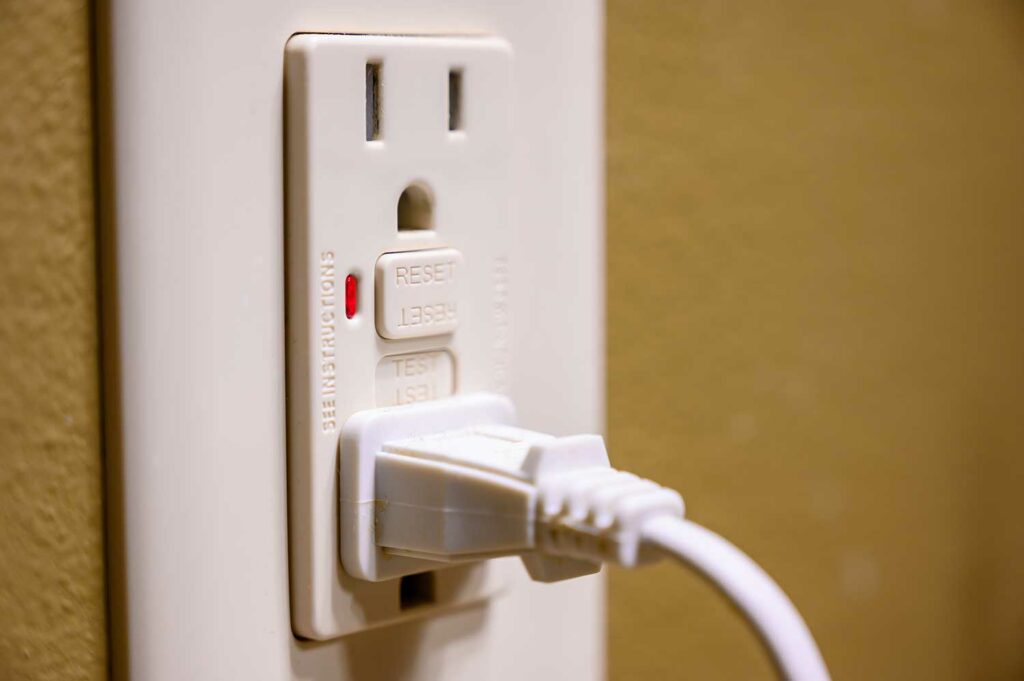Home inspection fixes are easily made for around 20-bucks. Through the years we have found a great majority of the homes we examine pop up with many of the same repairs listed in the summary. Sometimes our customers get a bit jittery when they see these items marked in scary red highlighting.
You might find yourself cringing about what these red flags mean in terms of your hard-earned cash reserves. But, before you reach for that carb-loaded coping mechanism, let’s walk through some of these common—and more importantly cheap—fixes to put your mind at ease!
MISSING GFCI(s) – Home Inspection Fix #1
Otherwise known as a ground fault circuit interrupter. It’s an electrical safety device that is designed to quickly interrupt the flow of electricity to that fixture when moisture is detected. It’s constructed to protect equipment and to reduce the risk of serious harm from an ongoing electric shock. These babies are required for electrical receptacles in wet areas, like kitchens, bathrooms and patios.
As you can imagine, this is a big-time safety issue, and requires that scary red highlighting for a reason—even though their individual price tag at Home Depot is somewhere around 20 greenbacks.
Click here to view one example
MANUAL FLUE LOCK – Home Inspection Fix #2
Otherwise known as a damper stop clamp. When is a damper clamp required? A damper clamp is required by code when artificial gas logs (or a log lighter) are present in an open fireplace. When gas logs are in use, the fuel (whether natural gas or propane) is moving through the combustion process; this process may produce carbon monoxide. Adequate ventilation is absolutely necessary here. The clamp is designed to prevent accidental closure of the damper.
Living here in the desert as we do, we don’t find many wood-burning stoves, but if that’s what you have, then a manual flue lock is used to prevent heat loss.
You can find this easy fix on Amazon for around $7 (that’s right, waaaay under $20):
Damper-Clamp-Stop-Fireplace-Flue
SMOKE DETECTORS & CARBON MONOXIDE ALARMS – Home Inspection Fix #3
Most of us are familiar with these guys. Carbon monoxide detectors are a newer addition to mandatory safety home requirements, though, and for good reason. It’s an invisible, odorless, noxious gas that kills people every year, and is not to be trifled with. California State law requires smoke alarms and carbon monoxide alarms to be installed in all single family dwelling units. Based on 2019 California building codes, carbon monoxide alarms shall be installed per manufacturer’s installation instructions in each area/hallway adjacent to sleeping rooms, each bedroom containing (or opening to a bathroom containing) a fuel burning appliance, each story of the building, and any basement.
Here’s a link to a combination smoke detector and carbon monoxide alarm at Home Depot: (it’s about 40 dinero—but hey, it’s only because they’re sold together, honest!)
Combination Smoke Detector and Carbon Monoxide Alarms
NO SEISMIC STRAPPING FOR WATER HEATERS – Home Inspection Fix #4
Believe it or not, since 1982, the Uniform Plumbing Code has mandated seismic safety straps for water heaters. That’s why it’s kinda hard to believe the number of homes still behind on the times, especially living in earthquake country, as we do! The purpose of this requirement is to prevent fire, explosion or water damage if a water heater should topple during an earthquake. The seismic strapping keeps it fastened to the adjacent wall studs so that no plumbing or gas line breakage can occur during an earthquake. To ensure balanced and secure restraints each strap must be placed 1/3 of the way from the top and bottom of the unit.
Here’s a link to Home Depot for a pair of straps under 20 clams:
The Plumber’s Choice 55-Gal Seismic Water Heater Restraining Strap
5. MISSING DISHWASHER AIR GAP – Home Inspection Fix #5
A dishwasher air gap is a cylinder fitting that connects the kitchen sink drain to your dishwasher, preventing dirty water from flowing into the dishwasher as well as out of it during a wash cycle. (ew!) The truth is, an air gap is the most effective method to protect your dishwasher from flooding with wastewater. Stopped-up sinks and clogged tubing can send dirty water from the drain back into your dishwasher. Many plumbing codes do mandate dishwashers drain via an air gap fitting. But an air gap isn’t just a code-compliant annoyance, it’s a smart way to shelter your dishwasher from backflow. What I’ve noticed is after upgrading countertops, homeowners neglect to reinstall this little necessary protuberance; probably because it interrupts the aesthetic seamless look, but 10 times out of 10 this item is marked up for a reason.
Here’s a link to Home Depot air gap for just one more 20 bucks:
Westbrass 1 3 4 in Air Gap Kit
There are other similar-type home repair issues you may see on your report, but feel free to reach out to your friendly neighborhood inspector, (aka, me), anytime to answer whatever questions you may have! Hopefully browsing through this list has removed any need for cold feet. Even though some of these things will most likely be listed as necessary repairs—and rightly so—they will certainly not break the bank.
Cheerio folks!


